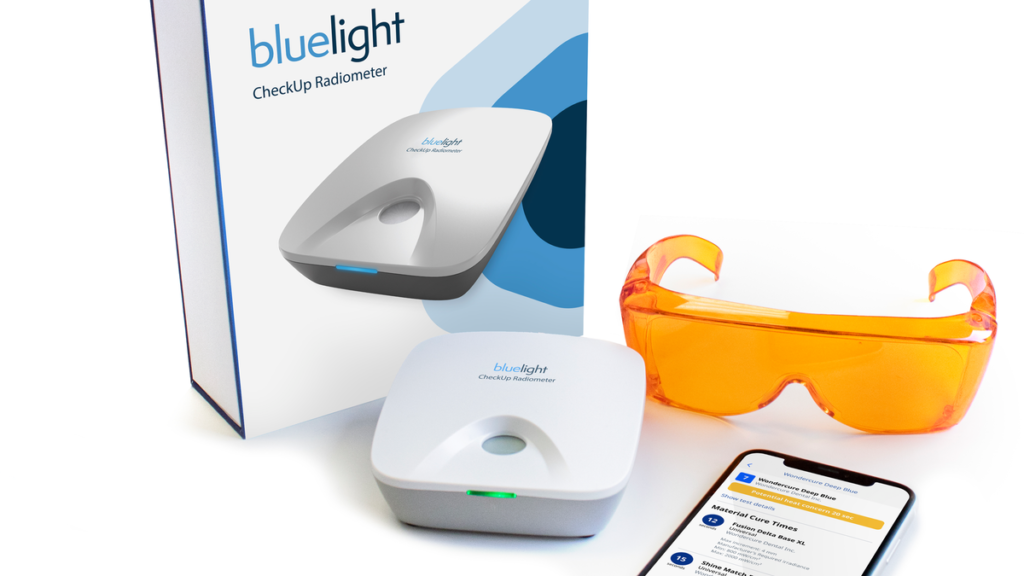
A Canadian-based company, Bluelight Analytics, recently announced that they are joining forces with 3M Oral Care to introduce Bluelight CheckUp radiometer to dentists around the globe. CheckUp was designed to help dentists improve the outcomes of their restorative procedures, primarily light curing. Similar to nanodentistry, this AI-driven technology can become a major disruption to the dental industry by aiming to automate old and complex processes.
“We are excited to work with Bluelight as we share a common mission — to help dentists improve the outcomes of their restorative dental procedures.”
Andrew Milder, global portfolio leader, 3M Oral Care
While light curing is just one small part of the restoration process, it has an extreme influence on the outcome. Although many light curing units (LCUs) have a built-in audible timer, the beep does not actually indicate whether the resin material was fully cured or not. Additionally, issues start to arise as the LCUs get older, showing a decrease in light output due to degradation of the fiber-optic light probe, breakage and fracture of the light tip, and showing presence of cured composite resin or debris on the exposed light tip.
Consequently, dentists routinely see resin-based composite (RBC) restorations showing signs of chipping, fracture, discoloration, loss of anatomical form, lack of retention, or secondary caries. Overall, these issues show signs of the fact that likely many RBCs placed in dental offices are under-cured.
Bluelight’s Answer to Undercuring – CheckUp
To combat these issues of inadequate energy delivery to RBCs, Bluelight Analytics has developed CheckUp, an AI-powered device that improves light-curing outcomes for dental practitioners worldwide. CheckUp is a dental radiometer that provides dentists with personalized insights and precise curing times for any combination of lights and materials.
The device has a large sensor that can collect all of the light emitted when a curing light is tested. However, the CheckUP’s main feature is its nonlinear sensor that is based on AI. CheckUp uses a machine-learning algorithm that compares and adjusts for different curing light characteristics, ensuring that each curing test result has the highest level of accuracy.
The algorithm is trained by thousands of measurements taken with a laboratory-grade integrating sphere and spectrometer systems. By taking a data-driven approach to light curing, Bluelight gives dentists the clinical insights they need to help them deliver great patient care and perform restorations that last.
3M Market Share Impact
Commonly referred to as the “Big 3” in the dental industry, 3M, Dentsply Sirona and Kerr Corporation collectively represented over half of the total U.S. dental materials market share.
In 2020, 3M was the market leader in the direct restorative materials segment, holding over 25% of the market share. While the company competed in both composites and GI/RMGI materials, they were the leading competitor in the former and the second-leading competitor in the latter. 3M has repeatedly introduced technological advancements to the science of dental composites. With even greater innovations on the rise, 3M’s partnership with Bluelight could become one of the driving factors that keeps the company ahead of its competition.
Direct Restorative Materials Statistics and Market Size
Initially, the introduction of light-curing components into the restorative materials allowed dentists to minimize air bubbles; therefore, they quickly replaced self-cured materials to account for over 80% of the total direct restorative units sold in 2020. Overall, the U.S. direct restoratives materials market was valued at over $550 million in 2020. This is expected to increase to over $725 million at an annual rate of over 4.5%.
Register to receive a free US Market Report Suite for Dental Materials 2020 – 2026 synopsis
One of the looming market limiters is the high financial barriers that limit access to dental care. Despite an unemployment rate of 3.7% in 2019, 23% of Americans lack dental insurance coverage. Historically, the sale of dental materials has been greatly correlated to the unemployment rate. Additionally, unit sales have been lower than expected in recent years, as employers are not offering the same level of benefits as in previous decades.
Via: Bluelight